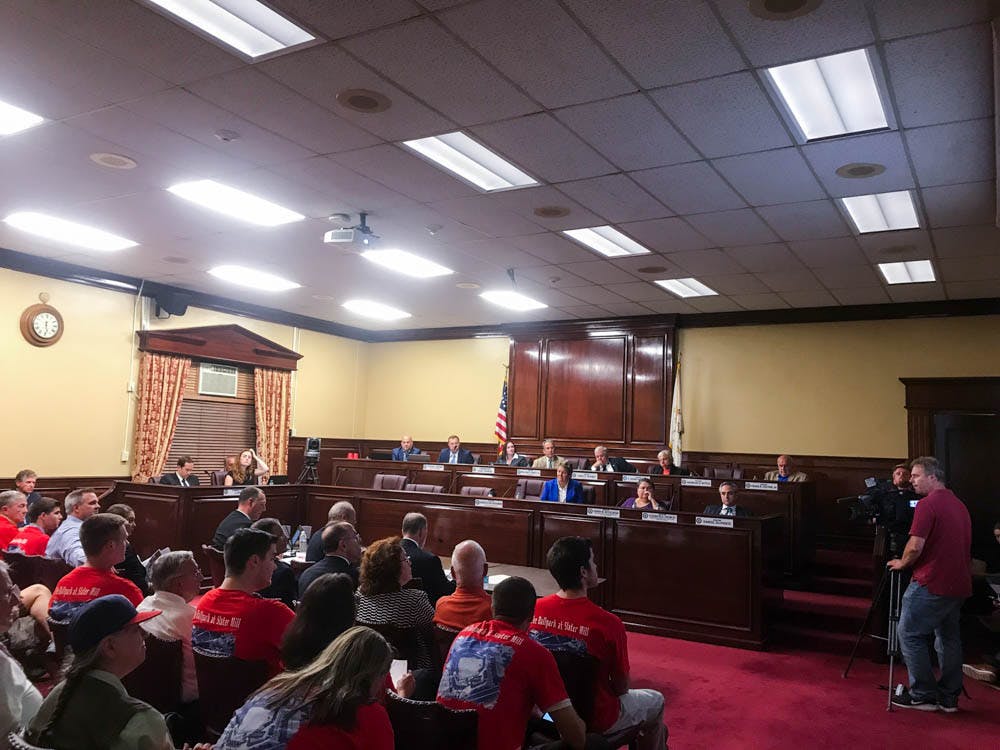“Pawtucket is home,” read the red shirts of Rhode Islanders who came out to the Senate Finance Committee Hearing Thursday to endorse the proposal for a new $83-million Pawtucket Red Sox Stadium at Slater Mill.
After the PawSox received an offer in July to make Worcester, Mass. the team’s new home, the Rhode Island community came together to review the proposal that would keep the PawSox in Pawtucket. The hearing at the Rhode Island State House is the first in a series of six that will take place through mid-October and result in a definitive conclusion regarding the construction of a “Fenway replica” in downtown Pawtucket.
The Pawtucket proposal would replace the old McCoy Stadium that housed the triple-A team for the past 75 years. Both the co-owner of the PawSox Larry Lucchino and PawSox Vice-Chairman Mike Tamburro listed some key issues of sustainability with the existing publicly-owned McCoy stadium — the location is distant from the city’s urban center and the stadium faces deteriorating conditions. Built on a pond, the building is subject to mold and recurring leaks.
“It’s been a great home, but it has done its job. … The bones are showing,” Lucchino said.
Maintaining the stadium is expensive, noted Pawtucket Mayor Donald Grebien. McCoy’s renovation would cost $58 million and rebuilding a new stadium on the current problematic site would increase the costs to an estimated $78 million, he said. Grebien added that even if renovated, the old McCoy stadium would not generate the same community impact as a new stadium would in a new location.
Building a new, larger stadium at Slater Mill in downtown Pawtucket will cost $83 million, of which $45 million will be invested by the PawSox — the largest private investment in downtown Pawtucket history. The state and the city of Pawtucket would split the remaining costs — $23 million and $15 million, respectively. Grebien assures the residents will face “no new taxes or tax increases” as the construction will be supported entirely by its stadium’s patrons and the PawSox team.
Co-owner Lucchino also said that “it will make Red Sox baseball sustainable and stable in Rhode Island until 2050.” The stadium’s proximity to Pawtucket’s urban center could also become a catalyst for positive redevelopment of Pawtucket, Lucchino said. Lucchino and Tamburro said they plan for the ballpark to function as a multi-purpose public space with full access for Rhode Island residents.
Andrew Maguire, a Pawtucket resident that went to the hearing, said the project would revitalize the Pawtucket community by providing a new site for events such as concerts, art festivals and farmers markets.
Moreover, Mayor Jorge Elorza said the stadium would invigorate the state’s economy: “This is a great opportunity that is going to benefit all of us through creating jobs.”
Lieutenant Governor of Rhode Island Daniel J. McKee agreed, saying that the Ballpark at Slater Mill will keep “viable business in the community” and is likely to turn revenue-positive for the state of Rhode Island.
The hearing, which lasted over four hours, gave limited time at the end for dissenters to voice their opinion. Critics have claimed that the state should not fund the stadium for a team owned by wealthy businessmen. Opponents and supporters will have a chance to be heard Sept. 26 at Tolman High School in Pawtucket.





